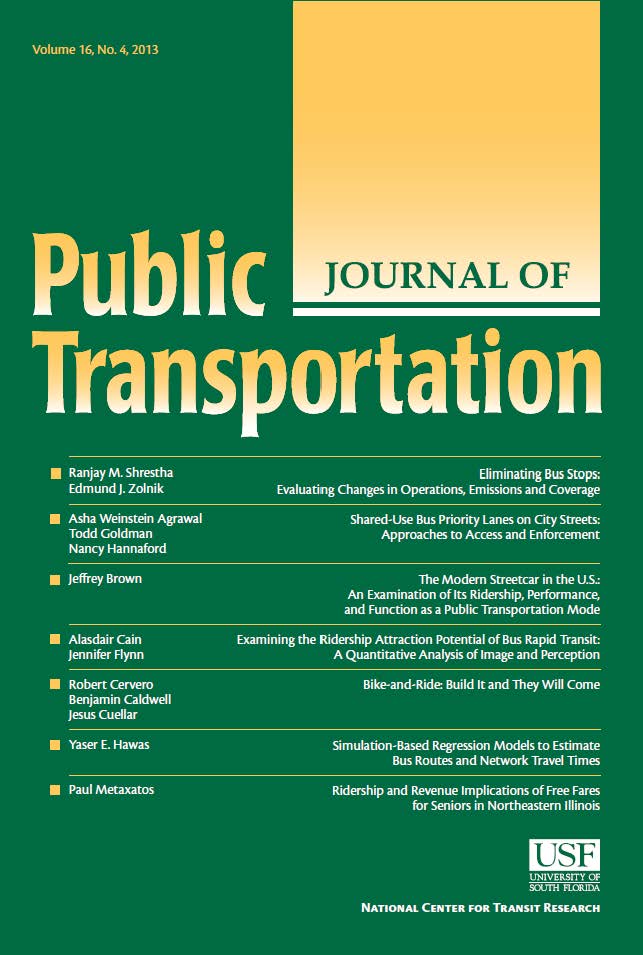基于轨迹数据的数据驱动因果行为建模:公共交通票价激励的案例
IF 2
4区 工程技术
Q3 TRANSPORTATION
引用次数: 0
摘要
使用统计和机器学习技术对行为建模进行了广泛的探索,主要依靠分析相关性来了解乘客在不同条件和场景下的反应。然而,相关性本身并不意味着因果关系。本文介绍了一种数据驱动的因果行为建模方法,包括两个阶段:因果发现和因果推理。因果发现阶段使用Peter-Clark (PC)算法学习捕获变量间因果关系的有向无环图。因果推理阶段估计相应的模型参数,并推断旨在影响用户行为的干预措施的(有条件的)因果效应。通过将结果与传统建模方法(逻辑回归和专家知识)的结果进行比较,验证了该方法的有效性,该方法使用的智能卡数据来自香港地下铁路系统的高峰前票价折扣激励计划的实际用例。结果表明,纯数据驱动的因果发现方法可以生成合理的因果图。该方法还可以量化激励的行为影响,识别关键影响因素,并估计相应的因果效应。激励的总体因果效应约为0.7 %,根据之前的统计分析,约有3 %的人口改变了行为。有趣的是,灵活性最高的乘客表现出消极的反应,而灵活性中高的乘客表现出3倍于一般水平的反应。该方法启动了数据驱动的人类行为动态因果模型,以支持政策制定和管理干预。本文章由计算机程序翻译,如有差异,请以英文原文为准。
Data-driven causal behaviour modelling from trajectory data: A case for fare incentives in public transport
Behaviour modelling has been widely explored using both statistical and machine learning techniques, primarily relying on analyzing correlations to understand passenger responses under different conditions and scenarios. However, correlation alone does not imply causation. This paper introduces a data-driven causal behaviour modelling approach, comprising two phases: causal discovery and causal inference. Causal discovery phase uses Peter-Clark (PC) algorithm to learn a directed acyclic graph that captures the causal relationships among variables. Causal inference phase estimates the corresponding model parameters and infers (conditional) causal effects of interventions designed to influence user behaviour. The method is validated by comparing the results with those from conventional modelling approaches (logistic regression and expert knowledge) using smart card data from a real-world use case on a pre-peak fare discount incentive program in the Hong Kong Mass Transit Railway system. The results highlight that the purely data-driven causal discovery method can produce reasonable causal graph. The method can also quantify the behavioural impacts of the incentive, identify key influencing factors, and estimate the corresponding causal effects. The overall causal effect of the incentive is approximately 0.7 %, with about 3 % of the population changing behaviour from previous statistical analysis. Interestingly, passengers with the highest flexibility exhibit a negative response, while those with medium-to-high flexibility demonstrate 3 times of the general level of responsiveness. The approach initiates the data-driven, causal modelling of human behaviour dynamics to support policy developments and managerial interventions.
求助全文
通过发布文献求助,成功后即可免费获取论文全文。
去求助
来源期刊

Journal of Public Transportation
TRANSPORTATION-
CiteScore
6.40
自引率
0.00%
发文量
29
审稿时长
26 days
期刊介绍:
The Journal of Public Transportation, affiliated with the Center for Urban Transportation Research, is an international peer-reviewed open access journal focused on various forms of public transportation. It publishes original research from diverse academic disciplines, including engineering, economics, planning, and policy, emphasizing innovative solutions to transportation challenges. Content covers mobility services available to the general public, such as line-based services and shared fleets, offering insights beneficial to passengers, agencies, service providers, and communities.
 求助内容:
求助内容: 应助结果提醒方式:
应助结果提醒方式:


